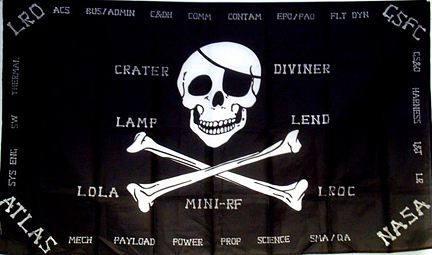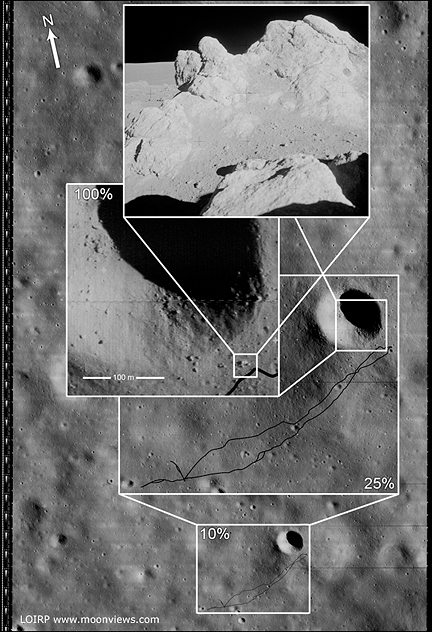
View larger image
The Earth as seen from the Moon! LROC NAC mosaic of images snapped on 12 June 2010 during a calibration sequence (Images E130954785L and E130954785R). Credit: NASA/Goddard/Arizona State University
Editor’s note: According to Mark Robinson at ASU “The full res version has a pixel scale of 3.7 km. The lead in web posting has a pixel scale of 12.4 km. If you follow the link you can get to the full resolution mosaic on the LROC webpage. Since this is an orthographic view the pixel scale is calculated at the center of the disc, the resolution falls off as a cosine function towards the limb.” Zoom in on the image here.
All cameras are susceptible to scattered light. You may have seen scattered light in pictures you have taken looking towards the Sun. Sunlight reflects off the optics and sometimes off the structure of the lens, and often appears as a gradient of brightness across the image. Attaching a baffle to your camera, like we did with the LROC Wide and Narrow Angle Cameras, can minimize this effect. More subtle effects are often present but usually you simply just don’t notice artifacts because of strong color contrasts in the scene. Since the Moon has only very small color contrasts, the LROC team must characterize even subtle scattered light effects within the 7-color Wide Angle Camera (WAC) images. Changes in composition (rock types) result in subtle differences of color, typically about 10% or less. For scientists to make accurate interpretations of WAC color maps, the amount of scattered light must be quantified (and preferably corrected). One way of measuring scattered light is imaging a bright object against a dark background. From the Moon, the Earth serves that function well. While a series of WAC calibration images of the Earth were being acquired, the Narrow Angle Camera (NAC) was shuttered to capture this spectacular Earth view. The bottom of the Earth was clipped because the prediction of the exact time when the cameras’ fields of view would cross the Earth was off by a few seconds.
Since the NAC acquires only one line of a picture at a time, the spacecraft had to be nodded across the Earth to build up the scene. The NAC Earth view is actually a mosaic of NAC-Left and NAC-Right images put together after calibration. The distance between the Moon and the Earth was 372,335 km when the picture was taken, with a pixel scale of about 3.7 km, and the center of this view of Earth is 25°N latitude, 114°E longitude (a few hundred kilometers north of Hong Kong).

View larger image
AP: Arabian Peninsula; CS: Caspian Sea; H: Himalayan Mountains; L: Lena River; I: Indian Ocean; A: Australia; J: Japan; P: Pacific Ocean; large yellow arrow indicates approximate position of the North Pole. Credit: NASA/Goddard/Arizona State University
It was a beautiful clear summer day over the North Pole. You can see ice covering most of the Arctic Ocean with a few leads of open water (dark) starting to open up. If you look very close you can follow the Lena River upstream from the Arctic Ocean all the way to Lake Baikal. Much of the Middle East was clear and you can trace spectacular swirl patterns of folded rock layers through Iran, Afghanistan, and Pakistan. These mountains formed as the Eurasian and Arabian tectonic plates collided.
Browse the full-sized image at the LRO Camera website maintained by Arizona State University.
 EMC Corporation (NYSE: EMC), the world leader in information infrastructure solutions, today announced that the Arizona State University School of Earth and Space Exploration (SESE) has deployed EMC Isilon(R) scale-out NAS to power the processing and analysis of tens of thousands of lunar images from NASA’s Lunar Reconnaissance Orbiter (LRO), with the aim of identifying ideal landing sites and areas of permanent shadow and illumination on the Moon’s surface. Using Isilon’s NL-Series, powered by the OneFS(R) operating system, SESE has consolidated its entire image processing, analysis and archiving workflow onto a single file system, simplifying big data management to reduce operating costs and increase research productivity. Additionally, using Isilon’s SyncIQ(R) asynchronous replication application, SESE can replicate its massive collection of lunar imagery to a second Isilon NL cluster to ensure maximum data reliability and availability.
EMC Corporation (NYSE: EMC), the world leader in information infrastructure solutions, today announced that the Arizona State University School of Earth and Space Exploration (SESE) has deployed EMC Isilon(R) scale-out NAS to power the processing and analysis of tens of thousands of lunar images from NASA’s Lunar Reconnaissance Orbiter (LRO), with the aim of identifying ideal landing sites and areas of permanent shadow and illumination on the Moon’s surface. Using Isilon’s NL-Series, powered by the OneFS(R) operating system, SESE has consolidated its entire image processing, analysis and archiving workflow onto a single file system, simplifying big data management to reduce operating costs and increase research productivity. Additionally, using Isilon’s SyncIQ(R) asynchronous replication application, SESE can replicate its massive collection of lunar imagery to a second Isilon NL cluster to ensure maximum data reliability and availability.









